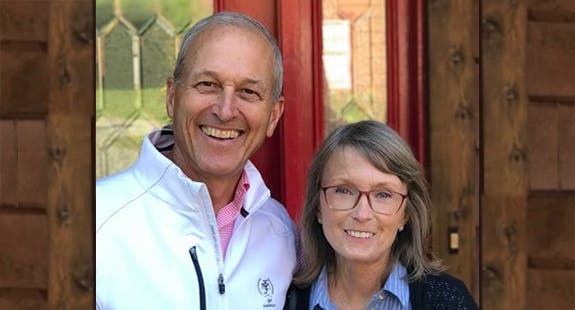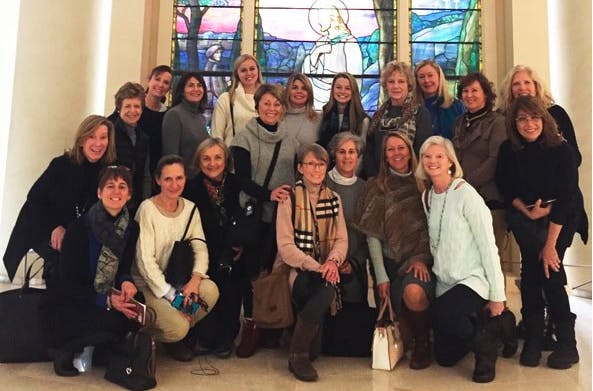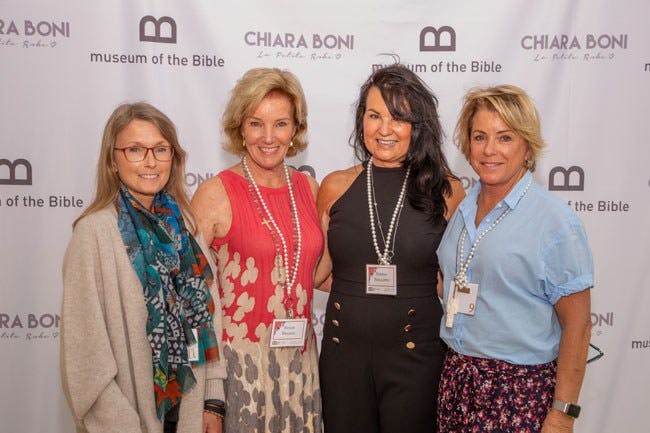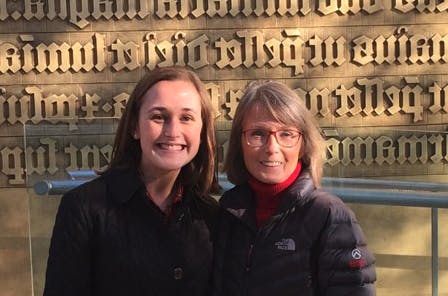Get to Know Annalisa Parks
Tell us about yourself
I am the youngest of three daughters raised in western Pennsylvania in a home that valued the Bible, family, country, and education. My mother faithfully read and studied her Bible, and I distinctly remember her challenging me in high school to read the Bible cover to cover. Over time, intellectual curiosity transformed into personally knowing God and his grace. I have poured over Scripture throughout my life, trying to grow, learn, and live in obedience. I have been blessed with an amazing career as an OB GYN, a faithful husband, and two wonderful daughters. I am a proud cancer survivor, but now live with several complications from my disease that made my former hobbies and activities impossible. Museum of the Bible entered my life when I was looking for a new and exciting challenge in my retired, post-cancer years. At the museum I was able to find meaning and help others. The people I have met, the things I have learned, and the museum community have stimulated my mind and heart.
How did you get connected to Museum of the Bible?
I was first introduced to Museum of the Bible at the President’s Gathering event in November of 2016. Perhaps you became acquainted with the museum through an event as well! At the President’s Gathering, the central message was that the museum would display the Bible with excellence—exceptional artifacts would be displayed, world-renowned scholars and curators would be integral to the permanent and temporary exhibits and events, the exhibits would not just be factual but also beautiful, and the display of the ancient text would be juxtaposed by state-of-the-art technology and modern interactives to make it a fun place for all generations to learn. All the presenters stressed that the museum should evoke awe in the visitors and stir in their hearts a desire to learn more about and engage more with the Bible. The museum would be a place unlike any other, where people of all backgrounds could come to trust the Word of God and apply it to their lives—I could not wait to be involved! Within a few months of the event you could find me cleaning equipment for the Hard Hat Tours and hungry to find more ways to help. Since this first volunteer opportunity, I have helped with guest services, trained to become a docent, regularly led tours, and recently mentored new docent trainees. Throughout the challenging season of this pandemic, I have continued to find new and unique ways to support the museum from afar.
What is your favorite part about being a docent?
There are so many aspects I love about the museum and being a docent. The most exciting is to witness or experience someone engage with the Bible in wonder. Learning about the artifacts is fascinating but seeing what text God has preserved through the centuries is one such experience. Did you know the oldest biblical text to date is the priestly blessing (Numbers 6:24–26)?
The Lord bless you and keep you:
The Lord make his face shine on you and be gracious to you:
The Lord turn his face toward you and give you peace.
Facts about this artifact from the late First Temple Period are displayed on the History Floor, showing these words from God, amazingly preserved from around 600 BC; so many guests are moved by this.
When touring the Dead Sea Scrolls exhibit, guests are amazed to learn the most intact scroll discovered is the Great Isaiah Scroll. It is the oldest almost-complete manuscript of Isaiah. Isaiah had difficult prophecies for Israel, was read by Jesus as his ministry began (Luke 4), has hopeful messianic prophecies, and is one of the three most quoted Old Testament books in the New Testament, amazing.
Preserved New Testament texts similarly awe guests. The P39 NT fragment is the oldest text from John 8, where Jesus declares his testimony is valid because he comes from the Father. The Wyman Fragment is the oldest copy of text from Romans chapters 4 and 5. God demonstrated his own love for us in this: while we were still sinners, Christ died for us. Codex Climaci Rescriptus is in a dialect of Aramaic that is very close to the Aramaic Jesus would have spoken and preserves the oldest text in that language of the Last Supper from the Gospel of Matthew. I see God’s hand in preserving these passages in these ancient artifacts, and it is a wonder to myself and guests.
All the artifacts and displays are wonderful, and you meet a wide range of people with diverse backgrounds and beliefs. It could be very easy to have antagonistic, controversial encounters yet there is a spirit of congenial cooperation. The collaborative effort is inspiring, but the best part is serving the guests, particularly trying to match guests’ interests with an artifact, display, or experience. Sometimes, even hearing the guest exclaim “Wow!” Here are a few stories from tours.
A college class tour was assigned to answer the question: Is the Bible relevant today? These students had varied biblical backgrounds and seemed disinterested. On the History Floor there was not much curiosity about the old manuscripts, however, the Doré Bible sparked interest. Doré’s images are the standard for all subsequent Bible imagery for the next 100 years. Classic Doré images are used over and over in Bibles, children’s illustrated Bibles, and movies (Cecille DeMille’s Ten Commandments). Images we are familiar with. Asked to conjure an image of Noah’s ark, they envisioned the ark on top of the mountain, the animals steadily winding down the mountain, the rainbow above in the sky with the doves flying away. The artifact was open to this engraving. Now the students are recalling past experiences with the Bible.
We talked about images and stories connecting with culture, such as how to slay a giant you need a sling shot references David and Goliath. Further connections were explored in Bible in America, seeing the Bible woven into our liberty, governance, and social movements. By the time they arrived at the Bible in the World, they eagerly scattered to interact with the various exhibits. It would have been so exciting to read their essays on the Bible’s relevance today.
An international couple arrived at Museum of the Bible because it is on Fodor’s Top Ten DC Museums. Basically biblically illiterate, they admired the architecture, appreciating the biblical themes demonstrated in the building’s finishes; moving from dark to light, old transformed into new, and materials from all around the world. They asked great questions: Who was Moses? Why are the first five books of the Bible known as the Torah? I directed them to the Hebrew Bible Experience, and later they enthusiastically shared their impressions of the Narrative Floor.
Another tour was a group of ladies in town for a conference on being a docent. They were mostly interested in the collection’s history and the training for tours, but walking through exhibits the questions evolved from the mechanics of tours to the Bible. One lady volunteered at a tapestry museum, so we headed to The Tapestry of Light. A lively discussion developed over why light was so important to the artist. The development of luminescent thread was a metaphor of Revelation’s message of light. The unbound tapestry was another metaphor for the unbound message of Revelation. This group then visited the tapestry in Bible in America and reviewed its use for communicating themes and acting as a timeline for the gallery. Weaving our way to the History Floor, we spent some time at the Valmadonna Codex. We talked about the long history of persecution of Jews. The significance of this manuscript being the only known Hebrew book to have survived from England prior to the expulsion of Jews in AD 1290. One Jewish lady shared some of her family’s experiences. They shared their surprise and amazement at the depth and beauty of the museum.
If you had to choose one artifact from the museum, which would you choose and why?
That is really challenging because the depth of the collection spans a wide range of interests. The one artifact to visit is the Washington Pentateuch, which will be in its new display on the History Floor this November for the anniversary. This Masoretic Text from around AD 1000 is one of the earliest Hebrew Bibles known today. The Washington Pentateuch is a rare and significant Bible. It can be difficult to understand how the text of the Hebrew Bible (Old Testament) has been kept consistent for a thousand years. Jewish scribes, the Masoretes (ca. AD 600–ca. AD 1000), worked to preserve the writing and reading of the Tanakh. Their work is considered the authoritative text and is the foundation of almost every Bible today. Of these Hebrew Bibles, roughly a dozen intact manuscripts survive from that time. The Washington Pentateuch is one of two manuscripts in the United States. It is the only one on display in the United States. When you stand before this codex you are one of the first few thousand people to see it in hundreds of years. Make sure you visit the Washington Pentateuch if you visit for the anniversary or afterward.
Whatever your favorite exhibit is, or however you participate with the museum, hopefully this encourages you to continue to do so. Maybe you have had your own moment of awe and wonder while engaging with the Bible at Museum of the Bible. I hope you share it.
How do you hope to leave a legacy?
I live a simple life, made a little simpler by the COVID pandemic. I am just so grateful my daughters know the Lord. Perhaps the best legacy is seeing the love of the Lord embraced in the next generation and by all people.

Annalisa with her husband, David

Annalisa touring the Washington Golf and Country Club exercise classes on a snowy winter day in 2018

September 2019 Women of Legacy Summit and Reunion

Annalisa touring Museum of the Bible with her daughter, Micah